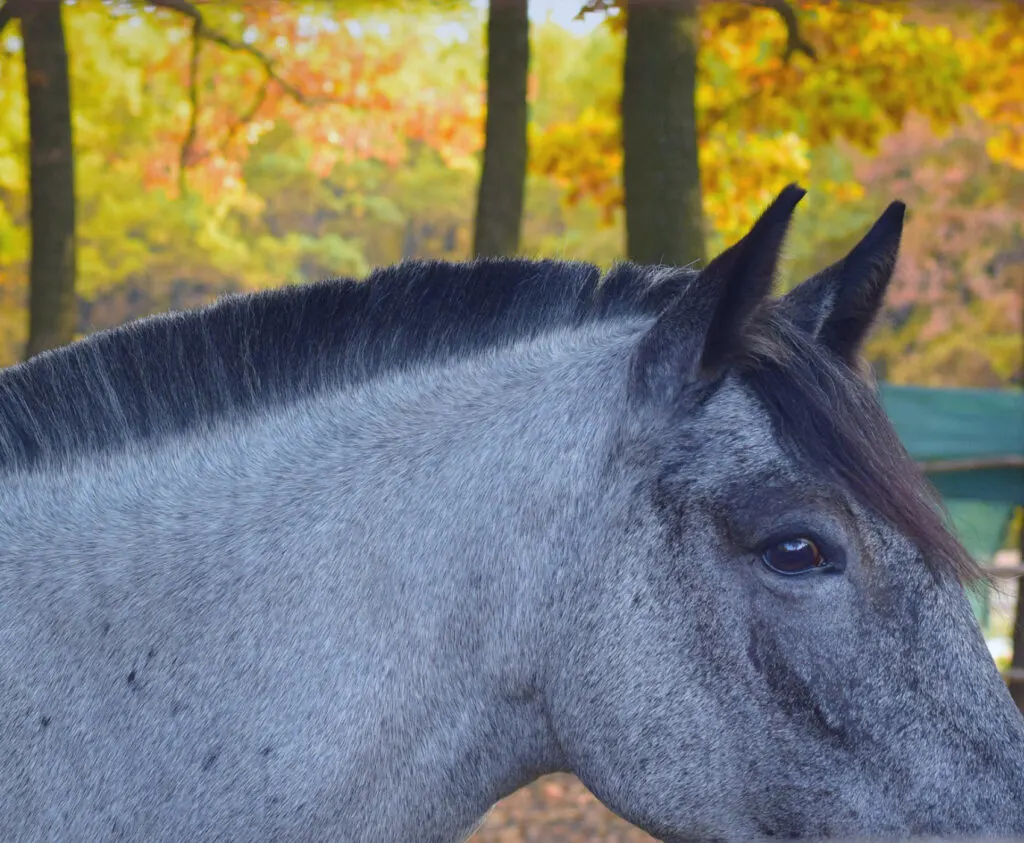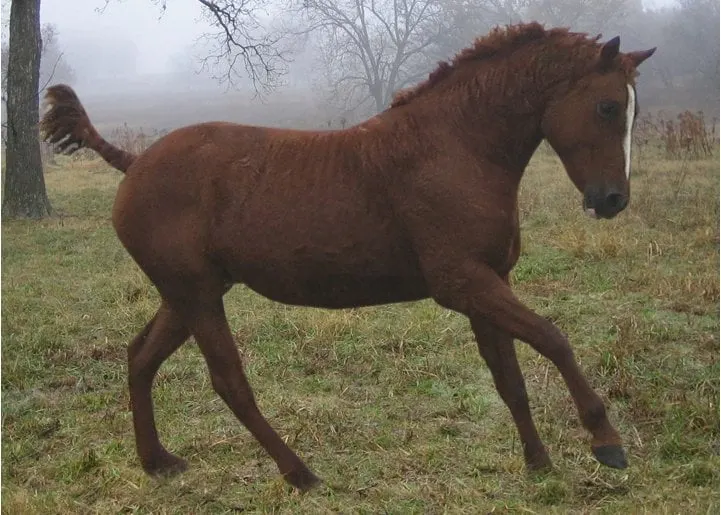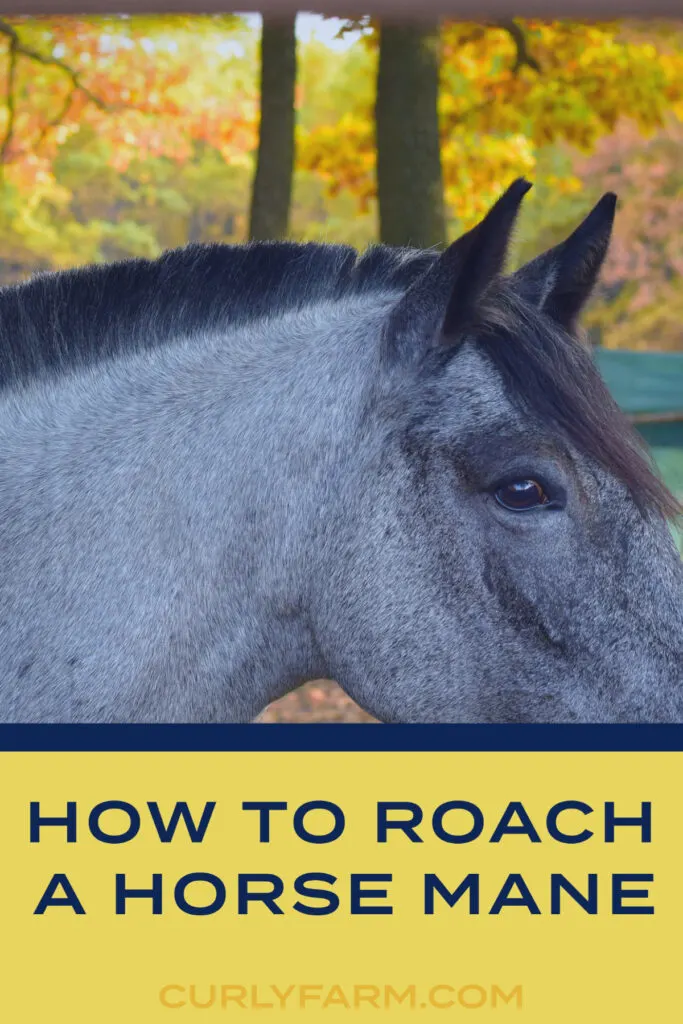Roached manes for horses (called “hogged manes” in some parts of the world) are cyclically popular. They fall out of fashion for a few years and then eventually return for a bit. A trend of roached horse manes never seems to fully catch on- probably because so many horse owners are emotionally attached to their horse’s mane! There are many benefits to roaching.
First, let’s discuss what it means for a horse to have a roached mane.
What is a roached mane for horses?
A roached mane is a horse mane that has been shaved close to the neckline. Similar to the human equivalent of a “buzzcut,” in which clippers are used to leave only a fraction of an inch of short spiky hair, mane roaching uses mechanical clippers to cut off a horse’s mane very close to the skin of the top of the neck. Usually, the forelock is left untouched in order to protect the horse’s eyes from flies.

Reasons people roach their horse’s mane:
1. Roached manes are easy to groom
Likely the number one reason that people roach their horse’s mane is that it simplifies grooming. Once a horse’s mane is roached, there is no more combing, detangling manes, or braiding required. Occasionally, if a person has given up on detangling a very tangled, dreadlocked, or bur-embedded mane, they’ll simply choose to roach it.
2. To Neaten up a Rubbed out Mane
Sometimes, if a horse has an itchy skin condition or spends too much time trying to graze between the rails of the fence line, they may rub the roots of their mane so aggressively that a section of hair falls out. When a horse rubs their mane in this way, leaving a big gap, some horse owners believe the easiest path towards an even mane length is through cutting off the rest of the manes so that the entire mane will grow out evenly.
3. Some people like the look of a roached mane
Some individual riders just appreciate the clean look of a roached mane. Alternately, it may be that the neckline of a particular horse happens to look great with a roached mane. Thirdly, in some horse sports (like polo) the roached mane may fit the aesthetic of the ideal horse for that event.
4. Roached manes might be slightly cooler
Although manes are protective for horses, that extra layer of hair laying on the neck can also be hot! For horses with very thick manes, roaching may be a way to help prevent overheating when training in hot and humid summer weather.

5. Roached manes are convenient for riders
If you find yourself having to pause riding lessons or horse training to detangle your horse’s wild mane from your reins, roaching could help. By keeping the neckline clean, roached manes can prevent interference with a rider’s reins.
In the 1970s, roached manes searched and popularity when the prominent trainers became convinced that horses could sense more subtle cues from their rider if mane was eliminated as an obstacle- a trend that was repeated mid-90’s in some dressage riding circles.
How to roach a horse’s mane
Supplies you’ll need:
a wide-tooth comb
scissors
clippers
thinning shears
1. If possible, comb the mane first so it lays flat and even
2. Comb the forelock forward, starting just behind the ears. (You can always cut more if the forelock is too bushy, but you can’t put hair back!)
3. Use scissors to cut the mane shorter- but not too close to the neck. Use scissors to cut the mane to about 3 inches long- this will allow the remaining hair to stand up straight, making it easier to use the clippers to get an even roach.
4. Use your clipper’s manufacturer instructions to roach down the crest of your horse’s neck, cutting the horse’s mane near the roots of the hair.
5. Optionally, take thinning shears to the remaining hair. Thinning shears will be helpful during the process of growing out the roached mane, as they can soften the look of boxy, unnatural hair growth.
How to decide if you should roach your horse’s mane
Deciding whether or not to roach is a personal decision. Some riders regret a roached mane, while others wonder why they hesitated so long to make the shift. Study your horses to get an idea of whether a roached mane would flatter their natural confirmation. For horses with an ewe neck, for example, roaching might be better left until the horse gains better muscle condition.

Try an Experiment:
Although arguably you can get a sense of how your horse might look with the roached mane by looking at them from their off-side (assuming they do not have a double mane), I recommend a different approach.
Since you are accustomed to seeing your horse from that side without mane, try combing the mane to the opposite side (so no mane shows on the near side). You may need to use water to get the mane to stay put, but this temporary comb-over will help your mind’s eye get a better sense of how your horse would look to you if their mane was shaved.
Roached mane versus hogged mane- are they the same thing?
In some parts of the world, shaving a horse’s mane is called “hogging,” and a horse with a hogged mane is just another way of saying that that horse has a mane that is cut very short or shaved.
Myth: Roached Manes won’t grow back normally
Fact: Hair is hair, growing out can have awkward stages but shaving doesn’t permanently change a horse’s hair type.
Growing out a horse’s mane after roaching it can be difficult, but that difficulty is mostly on the part of frustrated riders! Rumors abound – for both horses and humans – that hair that is shaved will grow back thicker or harder to manage. Luckily, countless studies have debunked this claim (here’s one, for reference)
You can expect that as your horse’s roached mane starts growing out it will do some funky stuff, but once the mane has grown some length, you’ll find that the texture and style of the mane post-roaching will be just the same as it was before.
The biggest challenge for riders trying to grow back the mane that has previously been roached is the patience to allow the hair to grow long enough. Trying to get a 4″ box-cut mane to lay over to one side will be a challenge, but thankfully it can be remedied with just a little bit more time.
How long does it take to grow out a roached mane?
Based on a recent survey of horse owners, horse manes grow about 1 inch per month (though individual horses vary significantly), so your horse’s roached mane should be long enough to fall to one side about 5-6 months after roaching, and should be long enough for braids by 7 to 8 months after being roached.
Tips for Growing out a Roached Mane
One of the chief complaints in the process of growing back out a roached mane is that the mane tends to have strange layers, boxy thickness, and unevenness. Thankfully, there are a few simple steps you can take to care for your horse’s roached mane as it is growing out that will help the new mane growth be more manageable.
Conditioning the mane, pulling it, and training it to lay over by using pasture braids can all be helpful ways to work with a roached mane as it is growing out. However, my best tip is to use thinning shears.
After all the waiting for a roached mane to grow back, you may balk at the idea of using scissors on the new mane growth, but hear me out! Thinning shears cut only a fraction of the hairs that are captured between their blades. Although thinning shears do cut hair, what they leave behind isn’t a clean-cut edge but a natural, organic edge. Naturally, the ends of both our hair and horse’s manes don’t all end at the exact same length- rather, it’s a variation in length that creates a nice edge.
At 2-4 inches long in the growing-back-out phase, thinning shears can be used on the edges to remove the boxy mohawk look. Thinning a bit near the roots of a roached mane in the mohawk stage can help thin some of the bulk of the new mane growth- and without that bulk supporting the mohawk, the mane should instantly be more agreeable to neatly flop over to one side.
Breeds that should and shouldn’t have Roached manes
Ultimately, it’s a horse owner’s choice about whether or not to roach your horse’s mane. That said, there are a few horse breeds in which roached manes are common or encouraged and if you braids in which roaching a mane is heavily discouraged:
Breeds in which roaching is discouraged: Andalusians, Spanish horses, Morgan horses, and Bashkir Curlies, etc
Breeds in which roaching is common: Thoroughbreds, Standardbreds, Ponies (both children’s ponies and polo ponies)
Roached Mane Alternatives: Before you Pull the Trigger
If you aren’t quite ready to make the leap to a roached mane, there are some things you can try first to help get your horse’s long and wild mane a little more controlled:
1. Braid your horse’s mane into a running braid before each ride. With practice, it only takes 2 to 3 minutes and can help keep even the thickest mane neat and out of the way of reins.
2. Use pasture braids between rides to prevent tangles and help your horse’s mane lay evenly when it’s not braided (Plus it’s a good chance to practice 4 strand braids!).
3. Using a Lycra slinky before events where your horse’s hair has to look especially neat – like horse shows – can be a good way to control wild manes.
4. When you bathe your horse, use conditioner on their mane. A leave-in conditioner might even be an option for your everyday grooming.
5. Thin the mane by pulling or using thinning shears. In decades past, manes were made more controllable by pulling out a portion of the horse’s hair. Thankfully, today’s thinning shears offer a faster, easier to use, and less traumatic option. Thinning shears can be used to neaten up any mane, and if you’re considering roaching but hesitant, try a very aggressive approach with the thinning shears to see if the mane can be made more manageable- if not, you can proceed to roaching the mane knowing you tried your best to save the length.
Horse Mohawks: growing out a Roached Mane
After a horse’s mane has been shaved using the roaching method, there is eventually a growing out period which can be very awkward. During the growing out phase, the thick base of coarse hairs tends to stand straight up- looking like a horse mohawk for weeks or even months.
To tame your horse’s mohawk, condition, train, thin, and eventually braid the mane to help it flop over like a short mane so it less resembles a mohawk. Using thinning shears can be a way to remove some of the bulk of mane hair supporting the vertical style and help gravity move the remaining mane into a more presentable traditional mane.

